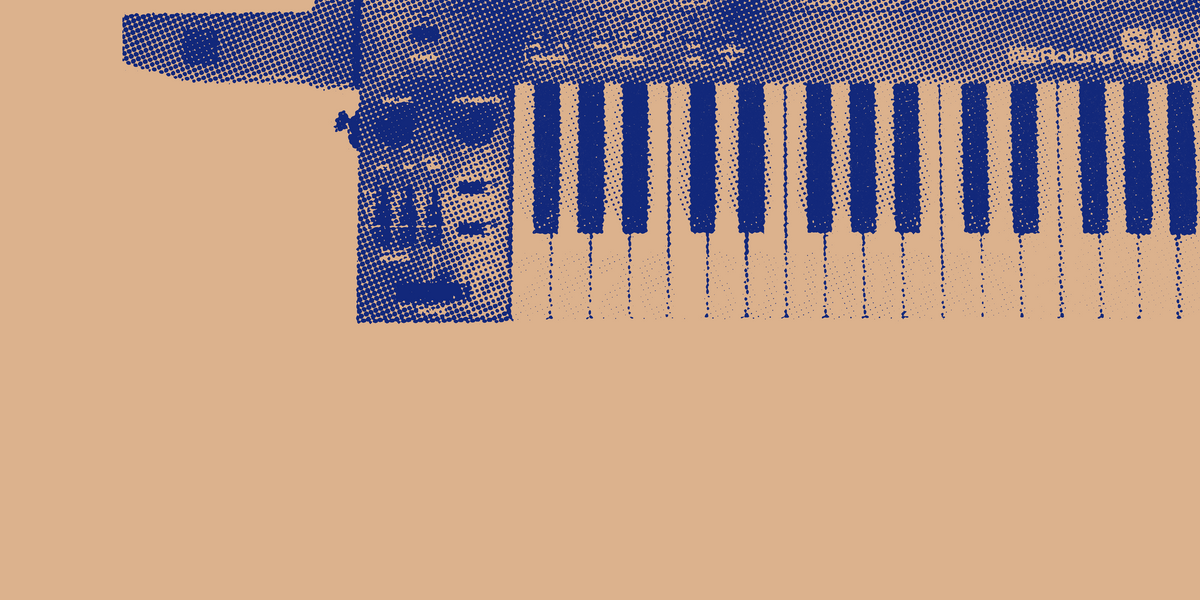The small and mighty Roland SH-101
Equally loved by electro bands in keytar mode, psytrance producers doing wild sweeps, or dub reggae plodding away, the SH-101 is a true icon.

It's small and plastic and simple and amazing. Whether being used awkwardly as a keytar in an electro band, resting calmly as the subby bass monster in a dub reggae act, or snarling along in a relentless psytrance set, the Roland SH-101 is the workhorse of the synthesizer in the world. Perhaps second only to the classic Juno series in its utility, if in many ways, often the invisible little cousin.
This humble monophonic analog synthesizer was only produced from 1982 to 1986, but became a cornerstone in the world of electronic music. Its compact design, affordability, and distinctive sound made it a favorite among musicians and producers. And maybe you too?
The Creation of the Roland SH-101
The Roland Corporation, a Japanese electronic musical instrument manufacturer, introduced the SH-101 in 1982. The company was already well-known for its innovative synthesizers, but the SH-101 marked a departure from its previous models. It was designed as a portable, user-friendly synthesizer that could be used both in studios and live performances.
The SH-101 was unique for its time, featuring a 32-key keyboard, a single oscillator, and a variety of controls for shaping sound. Its monophonic design allowed for the creation of rich, powerful basslines and lead sounds, which became a defining characteristic of the SH-101. The synthesizer was also notable for its portability, with a strap and a grip for pitch-bend and modulation, allowing musicians to use it as a keytar.
The design process of the SH-101 was driven by a desire to create a synthesizer that was both affordable and easy to use, without compromising on sound quality. The result was an instrument that was accessible to beginners but also had enough depth to satisfy more experienced musicians.
Impact on Music Culture
The SH-101 had a profound impact on music culture, particularly within electronic music genres. Its affordability and portability made it accessible to a wide range of musicians, from bedroom producers to touring artists. The synthesizer's distinctive sound became a staple in various music genres, including techno, house, and acid. Its ability to produce powerful basslines and sharp lead sounds contributed to the sonic landscapes of these genres, influencing their development and evolution.
In the realm of techno, the SH-101's raw and powerful sound became a defining characteristic of the genre. Its ability to produce deep, resonant basslines and piercing lead sounds made it a favorite among techno producers. The SH-101 was instrumental in shaping the sound of Detroit Techno, with artists like Juan Atkins and Derrick May using it to create their pioneering tracks.
In house music, the SH-101's warm, rich tones and its ability to create funky basslines and melodic leads made it a popular choice. Artists like Larry Heard and Marshall Jefferson used the SH-101 to craft tracks that helped define the sound of Chicago House.
In the genre of acid, the SH-101's squelchy, resonant sounds became a defining feature. The SH-101 was often used in conjunction with the Roland TB-303, another iconic Roland synthesizer, to create the genre's distinctive, psychedelic sound. Artists like Phuture and Plastikman used the SH-101 to create some of the genre's most iconic tracks. Beyond these genres, the SH-101 also found a home in other forms of electronic music, as well as pop, rock, and hip-hop. Its versatile sound and user-friendly design made it a valuable tool for a wide range of artists.
The SH-101's impact on music culture extends beyond the sounds it produced. Its user-friendly design and affordability helped to democratize music production, making it possible for more people to create music. This had a profound impact on the music industry, contributing to the rise of bedroom producers and the DIY music movement. Furthermore, the SH-101's distinctive look – with its colorful, plastic body and its optional hand grip and shoulder strap – made it a visual icon as well as a sonic one. It became a symbol of the 1980s music scene, and it continues to be associated with that era. YMMV on whether that's cool or not.
Notable uses of the Roland SH-101
The SH-101 has been used by numerous influential artists and can be heard on many iconic tracks. For instance, electronic music pioneers like Aphex Twin, Boards of Canada, and The Prodigy have all utilized the SH-101's unique sound in their music.
Aphex Twin, known for his innovative approach to electronic music, used the SH-101 extensively in his early works. He has often spoken about the influence of the SH-101 on his sound, praising its simplicity and flexibility. The synthesizer can be heard on tracks like "Digeridoo" and "Polynomial-C," where it provides the driving basslines and atmospheric leads.
Boards of Canada, a duo celebrated for their idiosyncratic soundscapes, also incorporated the SH-101 into their sonic palette. The synthesizer's warm, analog sound can be heard on tracks like "Roygbiv" and "Aquarius," where it contributes to the duo's nostalgic, dreamy sound.
The Prodigy's Liam Howlett used the SH-101 to create some of the band's most memorable basslines, contributing to their status as one of the most influential acts in electronic music. Tracks like "Firestarter" and "Breathe" feature the SH-101 prominently, showcasing its powerful, aggressive sound.
Technical Specifications
The SH-101 is renowned for its simplicity and functionality. It features a single Voltage-Controlled Oscillator (VCO) with three simultaneous waveforms: sawtooth, square, and pulse. The pulse width can be manually adjusted or modulated by the LFO, allowing for a wide range of tonal possibilities.
The Voltage-Controlled Filter (VCF) is a resonant low-pass filter with controls for cutoff, resonance, envelope modulation, and keyboard tracking. The filter can self-oscillate at high resonance settings, creating a sine wave that can be played chromatically across the keyboard.
The Voltage-Controlled Amplifier (VCA) can be controlled by the ADSR envelope or the gate, providing flexibility in shaping the volume contour of the sound. The ADSR envelope can also be inverted, allowing for creative sound design possibilities. The synthesizer also includes a simple sequencer and an arpeggiator, which contribute to its versatility and playability. The sequencer can store up to 100 notes, and the arpeggiator offers up, down, and up/down modes with a selectable octave range.
The SH-101 can be powered by batteries or an external power supply, and it includes a built-in speaker for portable use. It also features CV/Gate inputs and outputs, allowing it to interface with other analog gear. The portamento, transpose, and tune controls provide further options for shaping the sound and performance of the SH-101.
Comparison with Other Synthesizers
Compared to other synthesizers of its era, the SH-101 stood out for its portability, user-friendly design, and distinctive sound. While it lacked the polyphony of some competitors, its powerful monophonic sounds and intuitive controls made it a favorite among musicians.
The SH-101 was often compared to synthesizers like the Moog Prodigy and the Korg MS-20. While these synthesizers also offered powerful monophonic sounds, the SH-101 was more portable and affordable, making it a more accessible option for many musicians. Additionally, the SH-101's built-in sequencer and arpeggiator set it apart from many of its competitors, as did its ability to be played as a keytar.
Despite its simplicity, the SH-101 was capable of producing a wide range of sounds, from deep basses to piercing leads and atmospheric effects. This versatility, combined with its user-friendly design, made it a popular choice for musicians across a variety of genres.
The SH-101 in Modern Music Production
Even decades after its release, the SH-101 remains a sought-after instrument in modern music production. Its iconic sound can be heard in a variety of genres, from techno and house to pop and hip-hop. Many modern producers also use software emulations of the SH-101 to capture its distinctive sound.
In the realm of techno and house, the SH-101's powerful bass and lead sounds continue to be a staple. Producers like Richie Hawtin and Carl Craig have used the SH-101 to craft tracks that have defined these genres. In pop music, artists like Calvin Harris and Charli XCX have used the SH-101 (or its emulations) to add a touch of analog warmth to their tracks.
Software emulations of the SH-101, such as Roland's own SH-101 PLUG-OUT and the LuSH-101 by D16 Group, have made the synthesizer's sound accessible to a new generation of producers. These emulations replicate the sound and functionality of the original hardware, allowing producers to incorporate the SH-101's iconic sound into their music without needing to find and maintain a vintage unit.
The Legacy and Influence of the SH-101
The SH-101's influence extends far beyond the music it helped create. Its design and sound have inspired a multitude of other synthesizers, and its impact can be seen in the continued popularity of monophonic, analog synthesizers.
Many modern synthesizers, both hardware and software, owe a debt to the SH-101. Its straightforward, hands-on design has become a template for synthesizer interfaces, valued for its ease of use and intuitive layout. The SH-101's sound, particularly its powerful bass and lead sounds, has become a benchmark for analog synthesizer design.
The SH-101 has also influenced the way music is performed. Its portability and the option to be played as a keytar made it a popular choice for live performances, a trend that continues with modern keytar-style synthesizers.
Furthermore, the SH-101's built-in sequencer and arpeggiator were ahead of their time, and similar features have become standard on many modern synthesizers. These features not only provide creative options for sound design, but also enable more dynamic and engaging live performances.
Personal Anecdotes from Artists
Many artists have shared stories about their experiences with the SH-101, providing a personal perspective on its impact and influence. For instance, Aphex Twin, whose real name is Richard D. James, has often spoken about his fondness for the SH-101. He has described it as one of his favorite synthesizers, praising its simplicity and flexibility. James has also noted that the SH-101 was one of the first synthesizers he ever purchased, and it played a crucial role in shaping his early sound.
Boards of Canada, consisting of brothers Michael Sandison and Marcus Eoin, have also expressed their admiration for the SH-101. They have described it as a "workhorse" in their studio, praising its warm, analog sound and its ability to create a wide range of tones. The duo has used the SH-101 extensively in their music, and it has become a key component of their distinctive, nostalgic sound.
Liam Howlett of The Prodigy has shared that the SH-101 was instrumental in creating some of the band's most iconic tracks. He has described using the SH-101 to create powerful, aggressive basslines, and has praised the synthesizer's raw, unpolished sound. Howlett's use of the SH-101 has contributed to The Prodigy's status as one of the most influential acts in electronic music.
The SH-101 in Popular Culture
The SH-101 has made appearances in various forms of media, from music videos to films, further cementing its status as a cultural icon. Its distinctive look and sound make it instantly recognizable to many music fans.
In music videos, the SH-101 is often seen being played as a keytar, highlighting its unique design and portability. For instance, in the music video for "Firestarter" by The Prodigy, Liam Howlett can be seen playing an SH-101, showcasing its role in the band's music.
In film, the SH-101 has been used to create sound effects and score music. Its unique, versatile sound has made it a popular choice for sound designers and film composers. For instance, the SH-101 was used to create some of the iconic sounds in the sci-fi film "The Matrix," demonstrating its versatility and wide-ranging influence.
The Future of the SH-101
While the original SH-101 is no longer in production, its legacy lives on through software emulations and hardware reissues. Roland has released the SH-01A, a digital recreation of the SH-101 that replicates its sound and functionality in a compact, modern format. Software emulations, such as Roland's own SH-101 PLUG-OUT and the LuSH-101 by D16 Group, have also made the SH-101's sound accessible to a new generation of producers.
As long as musicians continue to value its unique sound and user-friendly design, the SH-101 will continue to be a relevant part of music culture. The continued popularity of its sound, both in its original form and in its various emulations and reissues, suggests that the SH-101 will remain an influential instrument for years to come. The future of the SH-101 also lies in the hands of the musicians who use it. As new genres emerge and music technology continues to evolve, it will be interesting to see how the SH-101 is used and reinterpreted by future generations of artists.
References
- Wikipedia contributors. (n.d.). Roland SH-101. In Wikipedia. Retrieved from https://en.wikipedia.org/wiki/Roland_SH-101
- Vintage Synth Explorer. (n.d.). Roland SH-101. Retrieved from http://www.vintagesynth.com/roland/sh101.php
- MusicRadar. (n.d.). 10 great things about the Roland SH-101. Retrieved from https://www.musicradar.com/news/10-great-things-roland-sh-101
- MusicRadar. (n.d.). Blast from the past: Roland SH-101. Retrieved from https://www.musicradar.com/news/tech/blast-from-the-past-roland-sh-101-598483
- Johnson, D. (n.d.). Roland SH101 [Retrozone]. Sound On Sound. Retrieved from https://www.soundonsound.com/reviews/roland-sh101-retrozone
- World's Greatest Mono Synth: Roland SH-101 [Video file]. Retrieved from https://www.youtube.com/watch?v=mlQs3VjKsGs
- Roland SH-101: Is It Worth It? [Video file]. Retrieved from https://www.youtube.com/watch?v=oyd3ivwG6a8
- The Roland SH101 In Action [Video file]. Retrieved from https://www.youtube.com/watch?v=za6tzUIzoXQ
- Classic, Simple, & Still Very Special // Roland's SH-101 [Video file]. Retrieved from https://www.youtube.com/watch?v=jl52FJCdrgk
- The Roland SH101 Analog Synth complete walk through [Video file]. Retrieved from https://www.youtube.com/watch?v=zR3U7za05dI
- MusicRadar. (n.d.). 10 great things about the Roland SH-101. Retrieved from https://www.musicradar.com/news/10-great-things-roland-sh-101
- MusicTech. (n.d.). Vintage Rewind: Remembering The Classic Roland SH-101. Retrieved from https://musictech.com/reviews/rewind-roland-sh-101/
- Johnson, D. (n.d.). Roland SH101 [Retrozone]. Sound On Sound. Retrieved from https://www.soundonsound.com/reviews/roland-sh101-retrozone
- Aisher, B. (n.d.). Roland Boutique SH-01A review. MusicRadar. Retrieved from https://www.musicradar.com/reviews/roland-boutique-sh-01a
- Sweetwater. (n.d.). Roland SH-101 VI Lifetime key Reviews. Retrieved from https://www.sweetwater.com/store/detail/RCldSH101--roland-sh-101-vi-lifetime-key/reviews


